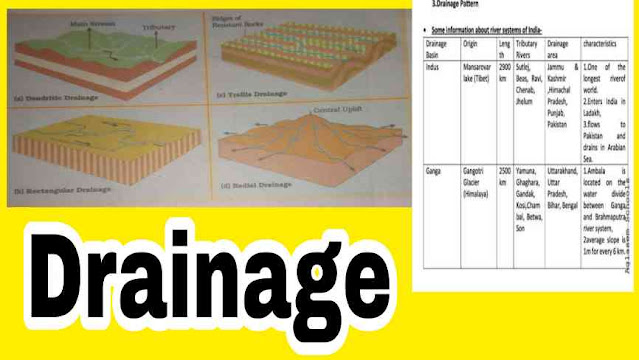Drainage clsss 9 notes
• Drainage means the river system of ares.
• The area drained by a single river system is known as drainage basin.
Drainage system in india
Drainage pattern
Role of rivers in the economy
National river conservation plant ( NRCP )
Lakes
Most lakes are permanent while others contain water only during the rainy season.
Some lakes are the result of the glacial action and ice sheets and some may have been formed by wind, river action and human activities.
A river meandering across a floodplain forms cut-offs that later develop into oxbow lakes.
Glacial lakes are formed when glaciers dig out a basin which is later filled with snowmelt.
Some lakes like Wular Lake in Jammu and Kashmir result from tectonic activity.
Apart from natural lakes, the damming of the rivers for the generation of hydel power has also led to the formation of lakes.
Lakes help to regulate river water flow, prevent flooding, aid to develop hydel power, moderate climate, maintain aquatic ecosystem, enhance natural beauty, develop tourism and provide recreation.
Role of Rivers in the Economy
Rivers are a natural source of water. It forms the main backbone for agriculture.
Settlements on the river banks have developed into cities.
Rivers are used for irrigation, navigation, hydropower generation, all vital for India, and agricultural economy.
Quality of river water is affected by the growing domestic, municipal, iftdustrial and agricultural demand.
A heavy load of untreated sewage and industrial effluents are emptied into the river affecting the river’s self-cleansing property.
Concern over rising pollution in our rivers led to the launching of various action plans to clean the rivers like Narmada Bachao Movement.
Conclusions
We provide short summary and some exam notes of all subjects and for all classes.this notes is related to class 12th commerce/arts indian economy notes.In our page we learn all classes subjects and different knowledge.our youtube channel also available so you get for information go to channel.now we work on application for all classes and easy way to get notes and pdf of exam idea so you ready to learn from our easy adda.



ConversionConversion EmoticonEmoticon